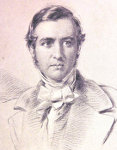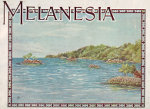

Charles Hyde Brooke (1841-1926)

 Christian mission in Melanesia had begun with a visit in 1848 by George Augustus Selwyn,
first Bishop of New Zealand, with the first baptisms four years later.
He recommended the creation of a new diocese, and a schooner Southern Cross (the first of a series of flagship vessels) was provided by friends to serve the work, which John Coleridge Patteson, responding to Bishop Selwyn's call, undertook from 1855, becoming Bishop of Melanesia six years later.
Brooke - his court case over - also responded to the call, and sailed to Auckland in 1865 on the Southern Cross,
and worked for two years as a lay missionary in the central Solomon islands, where he trained
young men, moving to Anudha. He was ordained deacon in 1867,
licensed to Florida [Gela] Island - left is his house there - and priest in 1869, moving that year
to Norfolk Island. Right is a traditional Solomon Islands kiala, or canoe house.
Christian mission in Melanesia had begun with a visit in 1848 by George Augustus Selwyn,
first Bishop of New Zealand, with the first baptisms four years later.
He recommended the creation of a new diocese, and a schooner Southern Cross (the first of a series of flagship vessels) was provided by friends to serve the work, which John Coleridge Patteson, responding to Bishop Selwyn's call, undertook from 1855, becoming Bishop of Melanesia six years later.
Brooke - his court case over - also responded to the call, and sailed to Auckland in 1865 on the Southern Cross,
and worked for two years as a lay missionary in the central Solomon islands, where he trained
young men, moving to Anudha. He was ordained deacon in 1867,
licensed to Florida [Gela] Island - left is his house there - and priest in 1869, moving that year
to Norfolk Island. Right is a traditional Solomon Islands kiala, or canoe house.| My dear Cousin, One line to you to-day of Christmas feelings and blessings. Indeed, you are daily in my thoughts and prayers. You would have rejoiced could you have seen us last Sunday or this morning at 7 A.M. Our fourteen Melanesian Communicants so reverent, and (apparently) earnest. On Sunday I ordained Mr. Palmer Priest, Mr. Atkin and Mr. Brooke Deacons. The service was a solemn one, in the Norfolk Island Church, the people joining heartily in the first ordination they had seen; Codrington’s sermon excellent, the singing good and thoroughly congregational, and the whole body of confirmed persons remaining to receive the Holy Communion. Our own little Chapel is very well decorated (Codrington again the leader) with fronds of tree-ferns, arums, and lilies; ‘Emmanuel, God amemina’ (with us), in large letters over the altar. |

 In 1871 Bishop Patteson [left] was martyred, on the island of Nakapu, mistaken
as a slave-trader when in fact he was visiting in an attempt to stamp
out the trade and establish peace after a recent attack. (He, together with a group of native martyrs a few years earlier, is
commemorated in the Anglican calendar on 20 September.) Hyde took part
in his funeral service, and on the anniversary of his death wrote a
memoir The Finished Course. Full historical transcripts of these events, and the early history of the mission, can be found here - including reports by Brooke from 1873 and 1873-4. From the start, indigenous ministry on the islands was strongly promoted; see here
for the Melanesian Mission today.
In 1871 Bishop Patteson [left] was martyred, on the island of Nakapu, mistaken
as a slave-trader when in fact he was visiting in an attempt to stamp
out the trade and establish peace after a recent attack. (He, together with a group of native martyrs a few years earlier, is
commemorated in the Anglican calendar on 20 September.) Hyde took part
in his funeral service, and on the anniversary of his death wrote a
memoir The Finished Course. Full historical transcripts of these events, and the early history of the mission, can be found here - including reports by Brooke from 1873 and 1873-4. From the start, indigenous ministry on the islands was strongly promoted; see here
for the Melanesian Mission today.Back to St Matthew Pell Street | Back to History